Alwyn Cashe personified everything the U.S. Army could possibly want in a Soldier. He was calm, cool, collected, and dedicated not just to the mission. He was dedicated to his men. That dedication would ultimately result in Sgt. Cashe gave up his life to save six others.
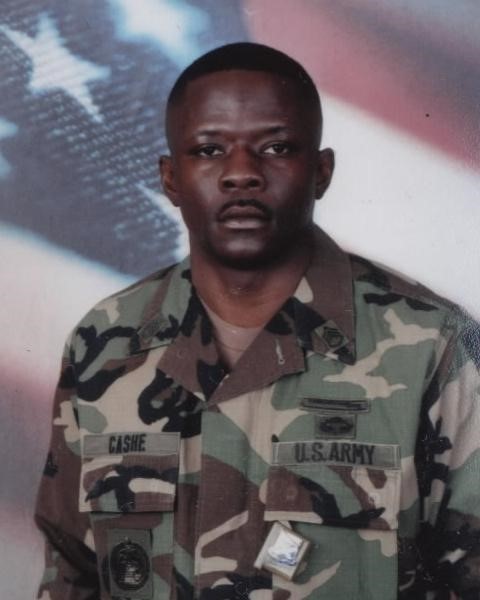 Cashe was born into a poor family in Oviedo, Florida, in 1970. He joined the U.S. Army 1989 as a Supply Specialist, but by 1993, he was retrained as an infantryman. He served in the Army as a squad leader, a Drill Sergeant, and, ultimately, a Platoon Sergeant. His career included deployments in the 1991 Gulf War, the former Yugoslavia, and the 2003 U.S.-led invasion of Iraq. But his second deployment to Iraq in 2005 would forever cement his legacy.
Cashe was born into a poor family in Oviedo, Florida, in 1970. He joined the U.S. Army 1989 as a Supply Specialist, but by 1993, he was retrained as an infantryman. He served in the Army as a squad leader, a Drill Sergeant, and, ultimately, a Platoon Sergeant. His career included deployments in the 1991 Gulf War, the former Yugoslavia, and the 2003 U.S.-led invasion of Iraq. But his second deployment to Iraq in 2005 would forever cement his legacy.
On October 17, 2005, Cashe was deployed to Salah Ad Din Province, Iraq, with the U.S. Army's 3rd Brigade, 3rd Infantry Division. While on a nighttime mounted patrol near Samarra, his Bradley Fighting Vehicle was hit by an improvised explosive device (or IED), which ruptured the armored vehicle's fuel cell and sent diesel fuel all over the area. To make matters worse, the attack was part of an ambush, and small arms fire began crackling through the night air.
Covered in diesel fuel, Cashe could exit the vehicle, which caught fire and began to burn. His first move was opening the driver's hatch to help the driver escape the vehicle. When he opened the hatch, he found the driver badly burned and still on fire. Cashe helped get the driver to safety, put the fire out, and then ran back to the Bradley.
But there were still six of his Soldiers inside the Bradley, and all were trapped, burning as flames engulfed the entire vehicle. Under fire from the enemy, Alwyn Cashe ran to their aid. He helped open the troop door and pulled them out of the burning vehicle one by one, even as the diesel fuel on hi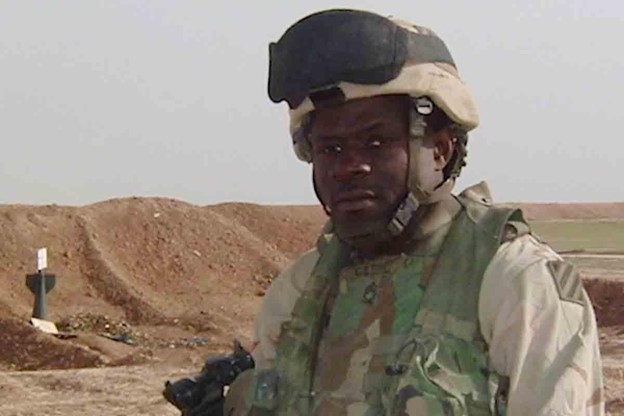 s own uniform caught fire.
s own uniform caught fire.
He helped lift four Soldiers from the wreckage, realized he was missing two, and then returned to retrieve them. The Iraqi translator died in the fire, but because of Cashe's bravery under fire and dedication to the men he called "my boys," none of his Soldiers died that night.
Reinforcements arrived to suppress the enemy attack, and a casualty collection point was soon established. Cashe's uniform had completely burned away, leaving him with second and third-degree burns over 72% of his body. When helicopters arrived to evacuate the wounded, Cashe stayed behind until all of his Soldiers were taken out first.
The wounded were all evacuated from the scene to Balad Air Base, where their wounds were treated. Along the way, Cashe asked repeatedly, "How are my guys? What's going on with them? Where are they at?" It was the same thing he asked after regaining consciousness at Brooke Army Medical Center in San Antonio. His first thought was always the well-being of his Soldiers.
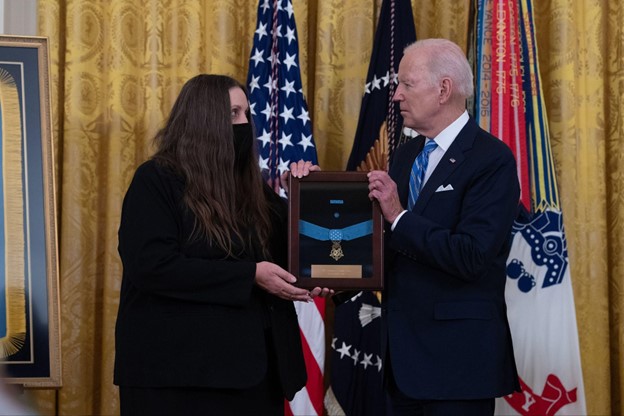 Cashe died weeks later, on November 8, 2005, at 35 years old. He was initially awarded the Silver Star for his heroism and dedication to his troops that night, but only because his battalion commander didn't realize the extent of Cashe's injuries that night and the excessive pain he must have experienced as he rescued his men.
Cashe died weeks later, on November 8, 2005, at 35 years old. He was initially awarded the Silver Star for his heroism and dedication to his troops that night, but only because his battalion commander didn't realize the extent of Cashe's injuries that night and the excessive pain he must have experienced as he rescued his men.
It took 16 years of constant effort, along with the help of three veteran members of Congress, but Sgt. 1st Class Alwyn Cashe's Silver Star was finally upgraded to the Medal of Honor. President Joe Biden presented the award to Cashe's wife, Tamara, in a White House ceremony on December 16, 2021.
The Battle of Leyte Gulf, fought between October 23 to 26, 1944, was the largest and one of the most decisive naval battles of World War II. With some 200,000 sailors involved, it might be the largest naval engagement in history. This monumental clash occurred in the waters surrounding the Philippine island of Leyte and marked a pivotal moment in the Pacific Theater. With its complex array of naval engagements, the battle ultimately led to a resounding victory for the Allied forces, further weakening the Japanese Empire and hastening the war's end.
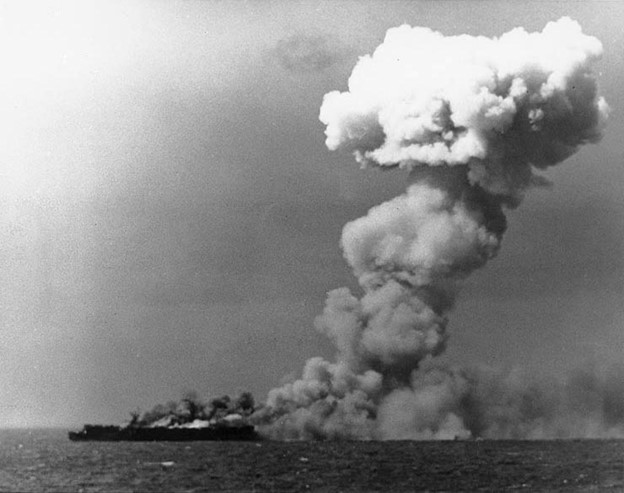 By the fall of 1944, Japan's imperial ambitions faltered, and the Allies were steadily advancing towards the Japanese home islands. The strategically important Philippines was a primary target for the Allies, as its capture would facilitate the liberation of other Southeast Asian nations and disrupt Japan's supply lines.
By the fall of 1944, Japan's imperial ambitions faltered, and the Allies were steadily advancing towards the Japanese home islands. The strategically important Philippines was a primary target for the Allies, as its capture would facilitate the liberation of other Southeast Asian nations and disrupt Japan's supply lines.
The Battle of Leyte Gulf unfolded as part of the larger operation that aimed to recapture the Philippines. American forces, under the command of Gen. Douglas MacArthur, initiated the operation with the invasion of Leyte on October 20, 1944. However, Japan was determined to defend its territory and deployed its remaining naval strength, known as the Center Force, to counter the Allied advance.
The battle was actually composed of four key engagements. The first was the Battle of Surigao Strait. This nighttime confrontation took place during the early hours of October 25, 1944, when the American 7th Fleet, led by Rear Adm. Jesse Oldendorf, ambushed the Japanese Southern Force as it attempted to enter Leyte Gulf. Employing a classic "crossing the T" formation, the American battleships unleashed a devastating barrage, crippling the Japanese. The battle resulted in the complete destruction of the Japanese battleships Yamashiro and Fuso, effectively eliminating any naval threat from the southern direction.
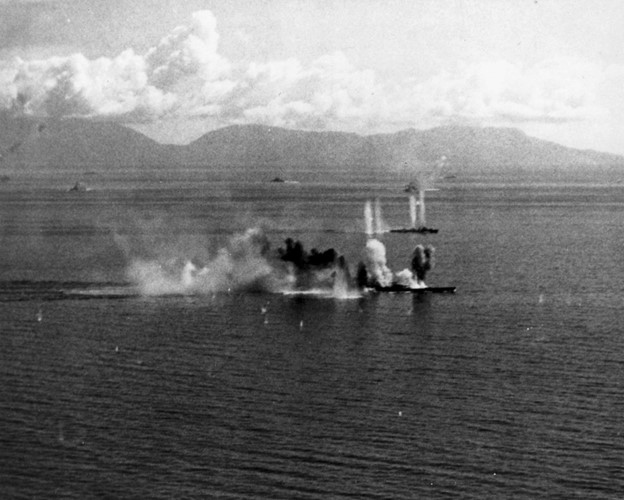 Meanwhile, the Japanese Center Force, commanded by Vice Adm. Takeo Kurita, pressed on toward Leyte Gulf. On October 25, 1944, this force encountered the American escort carriers and their supporting ships in the Battle of Samar. Outnumbered and outgunned, the American vessels displayed remarkable courage and resourcefulness. They launched a desperate counterattack, deploying aircraft and employing evasive maneuvers to fend off Kurita's superior Fleet. While the Battle of Samar was a tactical victory for the Japanese, the heroic efforts of the U.S. escort carriers and their crews disrupted Kurita's advance. They forced him to withdraw, saving the invasion force at Leyte.
Meanwhile, the Japanese Center Force, commanded by Vice Adm. Takeo Kurita, pressed on toward Leyte Gulf. On October 25, 1944, this force encountered the American escort carriers and their supporting ships in the Battle of Samar. Outnumbered and outgunned, the American vessels displayed remarkable courage and resourcefulness. They launched a desperate counterattack, deploying aircraft and employing evasive maneuvers to fend off Kurita's superior Fleet. While the Battle of Samar was a tactical victory for the Japanese, the heroic efforts of the U.S. escort carriers and their crews disrupted Kurita's advance. They forced him to withdraw, saving the invasion force at Leyte.
The final phase of the Battle of Leyte Gulf unfolded around Cape Engaño, where American carriers under Adm. William "Bull" Halsey lured the Japanese Northern Force away from the Leyte Gulf. This diversionary tactic convinced the Japanese that they were facing a more substantial threat than they actually were, as Halsey's carriers were faster and more maneuverable than the battleships and heavy cruisers of the Northern Force. As a result, Halsey's decoy maneuver drew the Northern Force away from the gulf, allowing the invasion to proceed.
On October 26, 1944, the remnants of the Japanese Fleet retreated. Although the Japanese had inflicted some damage on the American forces, they had failed to disrupt the Leyte invasion, and their naval power had been severely diminished. The battle marked a significant turning point in the Pacific War, as it effectively crippled Japan's ability to challenge Allied naval supremacy.
The Battle of Leyte Gulf remains a testament to the courage and determination of the men who fought on both sides. It showcased the adaptability and resourcefulness of the American forces, who, despite facing superior numbers, managed to secure a decisive victory. For Japan, the battle was a devastating blow, hastening the decline of its Empire.
The Battle of Leyte Gulf is remembered as a crucial moment in World War II, where the tide of the Pacific War definitively turned in favor of the Allies. The American victory at Leyte wasn't without casualties. Though the U.S. Navy sank 28 enemy ships for 12,000 casualties, it lost 12 ships of its own, with 3,000 American casualties.

After reading many of the Reflections of other veterans, I rediscovered how much my service time impacted my life. It helped me remember the people and places I served with and the friendships I made that still exist. I am in touch with several people who became lifelong friends while in the USAF.
Sgt Tom Duffy, US Air Force Veteran
Served 1968-1972
Before F.E. Warren Air Force Base had the power to destroy most of civilization, it was a tiny Army outpost on the American frontier, built to protect Union Pacific Railroad workers. Being the oldest continuously active Air Force installation comes with a lot of history, but like most of the military, its history can get pretty bloody.
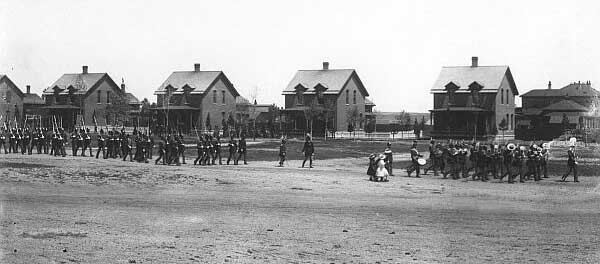 After 186 years of accidents, death, and destruction, you're bound to have a couple of ghosts hanging around, even in Wyoming – and F.E. Warren has all the ghosts you might expect.
After 186 years of accidents, death, and destruction, you're bound to have a couple of ghosts hanging around, even in Wyoming – and F.E. Warren has all the ghosts you might expect.
Today, Warren is part of the Air Force Global Strike Command and has an estimated 150 nuclear missiles ready to go whenever North Korea gets too big for its britches. Needless to say, times were very different when it was first built by the Army in 1867. It was initially named Fort D. A. Russell and was built for the 30th Infantry and Company H of the U.S. 2nd Cavalry.
Their mission was protecting workers and building the Transcontinental Railroad, and nearby Cheyenne, Wyoming, was America's railroad capital. One of the chief problems facing the construction of the railroad was that it passed through the traditional lands of the Sioux, Arapaho, Cheyenne, Crow, Blackfoot, Bannock, Snake, and Shoshone tribes, who would all aggressively defend their lands.
During the Civil War, the U.S. government was forced to focus its attention on beating the Confederates, and the Natives took full advantage of that shift in the West. 1865 was known as the "Bloody Year on the Plains." After taking a beating on the plains for five years while it fought the Civil War, the U.S. Army finally returned to protect the settlers and railway workers in a very proactive and violent way.
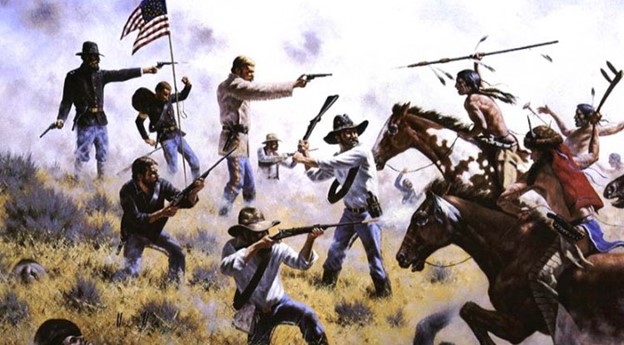 Scouts and cavalry from Fort Russell struck out from Cheyenne to hunt down marauding tribesmen who were using southern Montana as a base to conduct raids, steal livestock, and kill settlers. The American cavalry's chief tactic was to fight the Natives wherever they met them, turning the area into a 90,000–square–mile battlefield.
Scouts and cavalry from Fort Russell struck out from Cheyenne to hunt down marauding tribesmen who were using southern Montana as a base to conduct raids, steal livestock, and kill settlers. The American cavalry's chief tactic was to fight the Natives wherever they met them, turning the area into a 90,000–square–mile battlefield.
Between 1867 and 1895, the U.S. Army fought the tribes in a series of violent and bloody conflicts, including Red Cloud's War and the Great Sioux War, along with massacres at Sand Creek, Washita, Marias, and elsewhere. The Native tribes were, of course, eventually subjugated, but they did not go without a fight.
An estimated 8,500 tribesmen are believed to have died in battles during the Indian Wars of the latter half of the 19th Century. That number does not include women, children, and the elderly killed in Army raids and massacres in villages.
The U.S. Army lost around 1% of its total manpower in combat with Natives, numbering in the hundreds of troops killed in action. This number doesn't include the settlers killed in raids by Native bands. Total casualty figures are much higher on both sides.
 For the last 100-plus years, even after Fort Russell became F.E Warren Air Force Base, military personnel and civilians alike have reported seeing uniformed cavalry troops patrolling areas in and around the base. Warren is known as one of the most haunted places in Wyoming and the United States in general, and it's not only because of the spectral troopers.
For the last 100-plus years, even after Fort Russell became F.E Warren Air Force Base, military personnel and civilians alike have reported seeing uniformed cavalry troops patrolling areas in and around the base. Warren is known as one of the most haunted places in Wyoming and the United States in general, and it's not only because of the spectral troopers.
The current Security Forces building was once the base hospital, and in its basement was the morgue. SF airmen claim to see women walking around its corridors as if they were checking in on patients. Another haunted site was the scene of a grisly crime when an escaped mental patient killed six nurses where they slept. That building now houses the Wyoming Civil Air Patrol.
The most famous ghostly resident of F.E. Warren has to be a ghost called "Gus." The story goes that Gus was sleeping with an officer's wife when the officer surprised the lovers in bed. Gus decided to jump out a window but accidentally hanged himself on a clothesline. Now known as "Gus Quarters," Gus is said to be opening and closing cupboards and drawers, forever looking for his pants.
Army Together We Served currently records eight remembrances for members of the 761st Tank Battalion "Black Panthers":
Bates, Paul Levern, COL
Connelly, William A., SMA
Crecy, Warren G.H., MAJ
Jenkins, Earnest, PVT
Johnson, Lloyd, SGT
Mills, Earl F., CW4
Rivers, Ruben, S/SGT (MOH)
Robinson, Jack Roosevelt (Jackie), 2LT
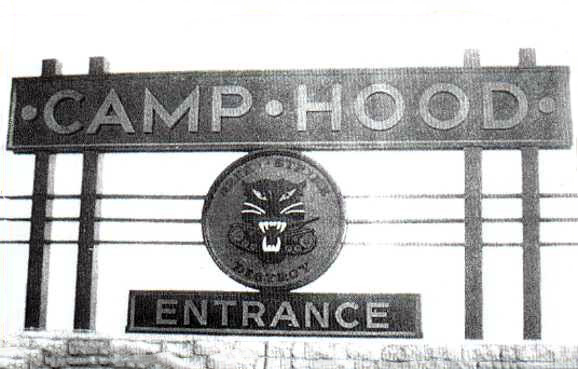 On January 14, 1942, at the beginning of the United States' involvement in World War II, it was announced that a Tank Destroyer Tactical and Firing Center would be established near Killeen, Texas. The 761st tank battalion was constituted on March 15, 1942, and activated in April at Camp Claiborne, LA. On November 21, 1941, General Marshall ordered the Tank Destroyer Force, developed by the Army Ground Force's General Leslie J. McNair, to be implemented at Camp Hood, Texas. They were charged with the mission to SEEK, STRIKE, and DESTROY enemy tanks. Camp Hood (later Fort Hood, now Fort Cavazos) is located in southwestern Bell and southeastern Coryell counties of Central Texas. Most of the 218,000 acres owned by the United States Army are located in Coryell County. The now famous Tank Destroyer SSI and 761st DUI were contemporaneous emblems. The black cat eating a tank was officially adopted for use by the 3rd Squadron of the 71st Cavalry Regiment, designed while at Camp Hood in 1944-45.
On January 14, 1942, at the beginning of the United States' involvement in World War II, it was announced that a Tank Destroyer Tactical and Firing Center would be established near Killeen, Texas. The 761st tank battalion was constituted on March 15, 1942, and activated in April at Camp Claiborne, LA. On November 21, 1941, General Marshall ordered the Tank Destroyer Force, developed by the Army Ground Force's General Leslie J. McNair, to be implemented at Camp Hood, Texas. They were charged with the mission to SEEK, STRIKE, and DESTROY enemy tanks. Camp Hood (later Fort Hood, now Fort Cavazos) is located in southwestern Bell and southeastern Coryell counties of Central Texas. Most of the 218,000 acres owned by the United States Army are located in Coryell County. The now famous Tank Destroyer SSI and 761st DUI were contemporaneous emblems. The black cat eating a tank was officially adopted for use by the 3rd Squadron of the 71st Cavalry Regiment, designed while at Camp Hood in 1944-45.
Throughout its history, about 710 soldiers were officially assigned to the Battalion. Twenty-four were KIA, 84 WIA, and 44 MIA from that roster. They arrived at Saint-Nicholas, France, in October 1944, saw first action on November 8, and endured 183 total days of battle, liberating thirty towns in six countries, including helping capture Goering's castle, until deactivated in 1946 – decades before the 21st century Black Panther movie superhero or mid-1960s advent of the Black Panther Party. These stereotypically gruff words from Third Army Commander Lt. Gen. George Patton was their welcome in their vital mission in defeating Nazi Germany in WWII: "Men, you're the first Negro tankers to ever fight in the American Army. I would never have asked for you if you weren't good. I have nothing but the best in my Army. I don't care what color you are as long as you go up there and kill those Kraut sons of bitches. Everyone has their eyes on you and is expecting great things from you. Most of all, your race is looking forward to you. Don't let them down, and damn you, don't let me down!"
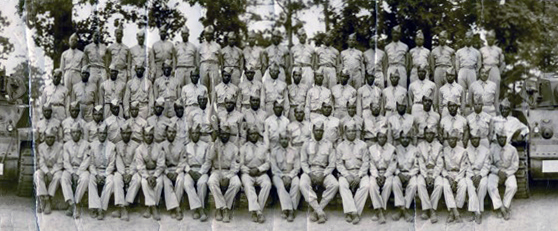 Kareem Abdul-Jabbar, who authored the book "Brothers in Arms: The Epic Story of the 761st Tank Battalion, WWII's Forgotten Heroes," wrote of them: "Certainly, they were General Patton's most effective unit… Because they were a replacement unit, they often shifted around to different areas. In every instance, their presence meant that competent tank support had arrived. The commander of the 17th Airborne, Gen. John Miley, felt that he could send many more of his Soldiers home alive as a direct result of the effective support of the 761st."
Kareem Abdul-Jabbar, who authored the book "Brothers in Arms: The Epic Story of the 761st Tank Battalion, WWII's Forgotten Heroes," wrote of them: "Certainly, they were General Patton's most effective unit… Because they were a replacement unit, they often shifted around to different areas. In every instance, their presence meant that competent tank support had arrived. The commander of the 17th Airborne, Gen. John Miley, felt that he could send many more of his Soldiers home alive as a direct result of the effective support of the 761st."
In early 1942, the Battalion began training in M5 Stuart light tanks. They learned to maneuver, mount, dismount, and maintain the vehicle's 37 mm main gun and .30 caliber machine guns. The Battalion was eventually moved to Camp Hood, Texas, where they would train for over two years. The men trained in M4 Sherman medium tanks and again in the M5 Stuart light tank. After a brief deployment to England, the 761st landed in France via Omaha Beach. From the time they entered combat until the end of the war in Europe, the men of the 761st received seven Silver Stars, 246 Purple Hearts, and one Congressional Medal of Honor. The Battalion would play a major role in the bitter Battle of the Bulge as the German's last-ditch offensive was successfully countered. Afterward, the Panthers opened the way for the US 4th Armored Division into Germany during an action that breached the Siegfried Line. The 761st helped break out and rescue the encircled American Army of Bastogne.
By the end of April 1945, the unit would be among the earliest US battalions to meet up with Soviet forces. In the final days of the war in Europe, the 761st was one of the first American units to reach Steyr, Austria, at the Enns River, where they met with the 1st Ukrainian Front of the Soviet Red Army. The convergence of the Russian and US armies split the final remnants of the Wehrmacht in two, hastening an end to World War II in Europe. The 761st would remain in Germany for another year before being deactivated on June 1, 1946, and sent home. It would be another three years until the US armed forces began integrating when then-President Harry S. Truman signed Executive Order 9981 on July 26, 1948. In its history, the Battalion had 30-36 black officers, six white officers, and 676 enlisted men by 1942. After the war, the Army awarded the unit with four campaign ribbons. President Jimmy Carter awarded the Battalion a Presidential Unit Citation for Extraordinary Heroism.
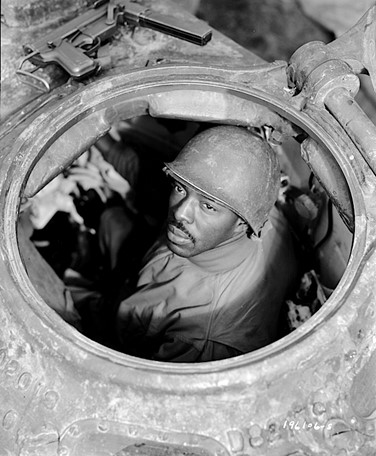 Sgt. Ruben Rivers of the 761st was posthumously awarded the Medal of Honor on January 13, 1997, by President Bill Clinton. The award was presented to Rivers' sister, Grace Wood, ford in attendance that day at the White House. His citation reads:
Sgt. Ruben Rivers of the 761st was posthumously awarded the Medal of Honor on January 13, 1997, by President Bill Clinton. The award was presented to Rivers' sister, Grace Wood, ford in attendance that day at the White House. His citation reads:
"For conspicuous gallantry and intrepidity at the risk of his life above and beyond the call of duty: Staff Sergeant Rivers distinguished himself by extraordinary heroism in action during 16-19 November 1944, while serving with Company A, 761st Tank Battalion. On November 16, 1944, while advancing toward Guébling, France, Staff Sergeant Rivers' tank hit a mine at a railroad crossing. Although severely wounded, his leg slashed to the bone, Staff Sergeant Rivers declined an injection of morphine, refused to be evacuated, took command of another tank, and advanced with his company into Guébling the next day. Repeatedly refusing evacuation, Staff Sergeant Rivers continued to direct his tank's fire at enemy positions beyond the town through the morning of November 19, 1944. At dawn that day, Company A's tanks advanced toward Bourgaltoff, their next objective, but were stopped by enemy fire. Captain David J. Williams, the Company Commander, ordered his tanks to withdraw and take cover. Staff Sergeant Rivers, however, radioed that he had spotted the German antitank positions: "I see 'em. We'll fight 'em!" Staff Sergeant Rivers, joined by another Company A tank, opened fire on enemy tanks, covering Company A as they withdrew. While doing so, Staff Sergeant Rivers' tank was hit, killing him and wounding the rest of the crew. Staff Sergeant Rivers' fighting spirit and daring leadership were an inspiration to his unit and exemplify the highest traditions of military service."
Jackie Robinson was drafted on April 3, 1942, and was assigned to a cavalry unit at Fort Riley, Kansas. While there, with help and encouragement from Private Joe "Brown Bomber" Louis, the college-educated Corporal Robinson applied for Officers' Candidate School. Although the Army officially supported the training of black officers, few thus far had gained admittance to Fort Riley OCS. Lieutenant Jack "Jackie" Roosevelt Robinson of the 761st, an athlete who would become one of the greatest baseball players and Dodgers of all time, lost his chance to see combat when he refused to move to the back of a segregated military bus during an incident at Camp Hood, Texas in July 1944. The 761st Battalion's commander, Lt. Col. Paul L. Bates, refused to prosecute Robinson, but his superiors got around that by transferring the lieutenant to another unit, where he was court-martialed. Robinson was later acquitted, but too late to rejoin his previous unit.
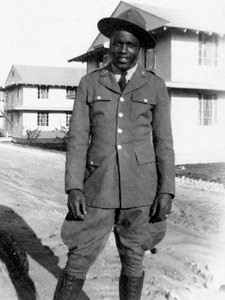 Jackie, Fort Riley 1942
Jackie, Fort Riley 1942
The 761st A Company Capt. John B. Long proudly summed up his pride for the Black Panthers and their conduct. "Not for God and country but for me and my people," he said. "This was my motivation, pure and simple when I entered the Army. I swore to myself there would never be a headline saying my men and I chickened. A soldier, in time of war, is supposed to accept the idea of dying. That's what he's there for: live with it and forget it. I expected to get killed, but whatever happened, I was determined to die an officer and a gentleman. . . . The town of Morville-les-Vic was supposed to be a snap, but it was an inferno; my men were tigers, and they fought like seasoned veterans. We got our lumps, but we took that f***ing town."
In May 1945, the Black Panthers were part of the Allied forces that liberated Gunskirchen, a subcamp of the Mauthausen concentration camp. One woman liberated by the unit, 17-year-old Sonia Schreiber Weitz, described the soldier who saved her in a poem, "The Black Messiah."
A black GI stood by the door
(I never saw a black before.)
He'll set me free before I die,
I thought he must be the Messiah.
A black Messiah came for me . . .
He stared with eyes that didn't see,
He never heard a single word
Which hung absurd upon my tongue.
And then he simply froze in place
The shock, the horror on his face,
He didn't weep, he didn't cry
But deep within his gentle eyes
. . . A flood of devastating pain,
his innocence forever slain.
For me, with yet another dawn
I found my black Messiah gone
And on we went our separate ways
For many years without a trace.
But there's a special bond we share
Which has grown strong because we dare
To live, to hope, to smile…and yet
We vow not ever to forget.
Sonia was 16 years old when US troops liberated her and her sister Blanca, together with circa 85,000 other prisoners, from Mauthausen. Sonia and Blanca spent three years in a displaced persons camp after the war, waiting for relatives to claim them, but no other family members survived. Along that same line, Anthony Blinken, our current US Secretary of State, recounted that his own stepfather, Samuel Pisar, was also rescued from the Holocaust by the 761st as they moved into the region. "'He ran to the tank. The hatch opened. An African American GI looked down at him. He fell to his knees and said the only three words he knew in English that his mother had taught him: 'God Bless America.' The GI lifted him into the tank, into America, into freedom." Blinken's half-sister, Leah Pisar, said that the soldier's name was Sgt. Bill Ellington. Samuel, an attorney who advised American and French presidents in the 1960s and 1970s, was one of the youngest survivors of a concentration camp in occupied Poland.
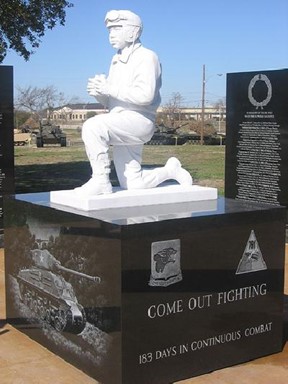 A monument featuring the kneeling Sgt. Ruben Rivers and, dedicated to the 761st, was unveiled at Fort Cavazos, Texas, during a ceremony attended by surviving veterans on November 10, 2005, as a "… permanent tribute to soldiers who had served and continued to serve throughout the world for liberty, honor, and democracy." Another marble panel with French text inscription was placed in the town of Morville-les-Vic dedicated to twelve soldiers of the 761st Tank Battalion who lost their lives in the town's liberation and are named on it. A third memorial for the Black Panthers, who were attached to the 87th Infantry Division while fighting during the Battle of the Bulge in 1944/45, was dedicated in the Belgian town of Tillet in 2021. And today, there's a bronze one at Camp Claiborne, too.
A monument featuring the kneeling Sgt. Ruben Rivers and, dedicated to the 761st, was unveiled at Fort Cavazos, Texas, during a ceremony attended by surviving veterans on November 10, 2005, as a "… permanent tribute to soldiers who had served and continued to serve throughout the world for liberty, honor, and democracy." Another marble panel with French text inscription was placed in the town of Morville-les-Vic dedicated to twelve soldiers of the 761st Tank Battalion who lost their lives in the town's liberation and are named on it. A third memorial for the Black Panthers, who were attached to the 87th Infantry Division while fighting during the Battle of the Bulge in 1944/45, was dedicated in the Belgian town of Tillet in 2021. And today, there's a bronze one at Camp Claiborne, too.
During their combat history, they had advanced with the 409th ID and been attached to:
Third Army:
4th Armored Division (United States)
1st, 26th, 71st and 87th Infantry Divisions
17th Airborne Division (United States)
17th Armored Group
Seventh Army:
1st and 103rd Infantry Divisions
Ninth Army:
79th and 95th Infantry Divisions
XVI Corps
Among many books that mention the 761st in order of battle chronology, nine more extensive narratives have been published featuring the unit. As much as other documentary and video productions, actor and USAF veteran Morgan Freeman, who had originally pitched the story to Steven Spielberg, inspired and, with 761st historian Wayne Robinson, narrated a two-hour cultural awareness film, 761st Tank Battalion: The Original Black Panthers, which premiered August 20 2023 on The History Channel. Freeman said, "The main thing about doing anything like this is to open the doors of American history as part of who we are as a people. Believe us when we tell you, there was nothing anybody, any group, has done that we weren't involved in making this country – this country… it's your story, and if it needs telling, nobody else is gonna tell your story. They tell their own story. So if you want yours told, you got to tell it yourself. So here we are."

It all has to do with being able to communicate with those who know what it was like. It's sort of a "band of brothers" thing. We were there, we did it, and only we did it. It is a great site for reconnecting with old buddies and meeting new ones. In the photo, Jim, on the left, was the coxswain on 40432 in 1966, at the same time I was on board as EN. That's me on the right. Behind us is Bob, who was also a Base Manhattan 40 sailor. Together again 45 years later!
EN3 Mike Passaretti, US Coast Guard Veteran
Served 1964-1968
At the beginning of World War II, the world grappled with darkness and uncertainty. British and French forces had only barely survived the disaster at Dunkirk, and a Nazi invasion loomed over the British Isles. The Battle of Britain had yet to begin, but the people of England were all banding together to do whatever they could to defend their homes.
 That included a secretive group of witches and occultists in Highcliffe-on-Sea, who decided to come together and do their part to defend England the best way they knew how. Meeting in a forest in August 1940, the witches launched what they called Operation Cone of Power, a magical attack on Adolf Hitler himself – even though he was thousands of miles away in Berlin.
That included a secretive group of witches and occultists in Highcliffe-on-Sea, who decided to come together and do their part to defend England the best way they knew how. Meeting in a forest in August 1940, the witches launched what they called Operation Cone of Power, a magical attack on Adolf Hitler himself – even though he was thousands of miles away in Berlin.
Gerald Gardner, a retired British civil servant and founder of a neopagan brand of Wicca that bears his name. Operation Cone of Power was organized by his coven of witches, who would meet on Lammas Day, which marks the beginning of the harvest and is one of the eight sabbats (seasonal festivals).
Gardner believed that by harnessing the collective energy of a group of skilled practitioners, they could recreate a magical assault that had been passed down through generations of witches. He wrote that English witches could create a powerful magical cone of energy capable of affecting real-world events, and had twice before.
Witches, he believed, had intervened in the defense of England in 1588 to help the English fleet fight off the Spanish Armada. The next time they came to the defense of the Isles was in 1805, to end the threat of a French invasion led by Napoleon.
Operation Cone of Power was intended to influence the mind of Hitler, who was conquering Europe with brutal efficiency. The witches believed that by directing their magical energy towards Hitler, they could magically weaken his resolve, cloud his judgment, and ultimately lead to his downfall.
 On Lammas Eve, shortly before midnight on August 1, 1940, a coven of 17 witches and people descended from witches gathered in the New Forest, a mystical and ancient woodland in southern England. They chose this location for its spiritual significance and the natural energy they believed it contained. In the heart of the forest, the witches formed a circle near an ancient gallows tree called the "Naked Man" with Gardner at the center and conducted their ritual.
On Lammas Eve, shortly before midnight on August 1, 1940, a coven of 17 witches and people descended from witches gathered in the New Forest, a mystical and ancient woodland in southern England. They chose this location for its spiritual significance and the natural energy they believed it contained. In the heart of the forest, the witches formed a circle near an ancient gallows tree called the "Naked Man" with Gardner at the center and conducted their ritual.
There was no bonfire because of air raid wardens and the Nazi bomber threat, only a shuttered lantern pointing a light toward the German capital to focus the attack. The witches were totally naked (or "skyclad," in Wiccan terms) as they danced around in a spiral, building the magical energy they needed for the incantation.
Gardner began to chant. His chants were echoed by the dancers. The assault on Hitler's mind was on. They focused their collective will, visualizing a cone of energy extending from their circle towards Hitler, enveloping him in a shroud of magical influence.
It is difficult to ascertain the tangible effects of Operation Cone of Power on Hitler or the course of World War II. The only reason to believe the spell actually happened is because Gardner himself wrote about it in three books during the 1950s.
What is known is that Hitler and the Nazis were masters of Europe through 1941. From the Balkans in the East to France in the West, he was also allied with Fascist Italy in the South and enjoyed a nonaggression pact with the Soviet Union. Britain alone stood against him.
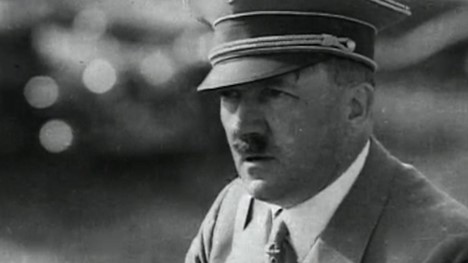 Those involved in the ritual claimed that they did perceive a change in Hitler's demeanor shortly after their operation. Hitler did indefinitely postpone Operation Sea Lion, the planned invasion of Britain, just a month and a half after the Cone of Power was cast. He then declared war on the United States after the Japanese attack on Pearl Harbor. He attacked the Soviets less than a year later.
Those involved in the ritual claimed that they did perceive a change in Hitler's demeanor shortly after their operation. Hitler did indefinitely postpone Operation Sea Lion, the planned invasion of Britain, just a month and a half after the Cone of Power was cast. He then declared war on the United States after the Japanese attack on Pearl Harbor. He attacked the Soviets less than a year later.
The witches took it as a sign that their magical efforts had some impact. Hitler did begin making his most egregious mistakes in the weeks and months that followed. Whether the magic was real or not, what was real was the patriotism of the Wiccans involved, who wanted to do anything they could to defend their homeland.
Since my book about Veterans Benefits – Veterans Benefits for You – came out in July, I have been interviewed on radio, television, podcasts, and different forms of social media. I have also discussed the benefits with company Veteran affinity groups and answered their questions.
 In these more than two dozen sessions, one common theme has emerged. Veterans are asking how they can help other Veterans. That is, what benefits or programs are there for a buddy facing difficulties that can help him/her change directions? Two benefits that I point out address are Financial Wellness and Veteran Homeless. Let me explain.
In these more than two dozen sessions, one common theme has emerged. Veterans are asking how they can help other Veterans. That is, what benefits or programs are there for a buddy facing difficulties that can help him/her change directions? Two benefits that I point out address are Financial Wellness and Veteran Homeless. Let me explain.
Financial Wellness
Because of the monthly fees, many Veterans do not use the banking system. They are referred to as unbanked Veterans. Instead, these unbanked Veterans use prepaid debit cards. This is risky and expensive. Risky because of identity theft or loss of the card. It is expensive because sizeable fees are paid on these transactions, resulting in less money available for living expenses.
To get Veterans banked, well-known banks and credit unions partnered with the U.S. Department of Veterans Affairs in 2019 to start the Veterans Benefits Banking Program (VBBP) https://veteransbenefitsbanking.org/. Through this program, Veterans can get a no-cost checking account at any of these federally insured institutions for their banking. Each provides a high level of customer service and protection from fraud. Since its inception, more than a quarter million Veterans have gotten banked through the program.
In addition to banking services, VBBP also provides Veterans with free and personalized financial counseling from professionals with The Association for Financial Counseling and Planning Education or The National Foundation for Credit Counseling. Any Veteran and their family can get a free counseling session in one of two areas:
Credit Counselling
- Your main goal is to get out of debt
- You are trying to avoid foreclosure or eviction
- You want to qualify for a first-time home purchase
Financial Counselling
- You want to gain information and guidance specific to your unique experience and needs.
- You want to create a budget, spending plan, or savings plan
- You are facing a lifecycle transition, such as education, a new job, or retirement
Share this information with your battle buddy who is challenged financially. These programs can improve their financial health.
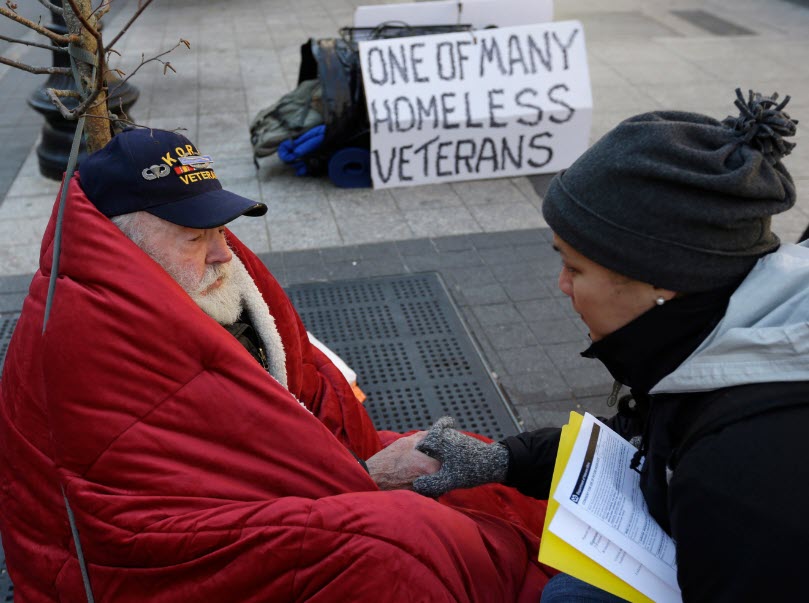 Veteran Homelessness
Veteran Homelessness
Many are aware of this tragic problem. Few recall the exact numbers, but it seems almost everyone has seen a person at a stoplight with a sign identifying them as a homeless Veteran. What can you do?
The positive news is that the VA has programs and resources to support homeless Veterans. One of the most effective programs is Support Services for Veterans Families (SSVF). Through grants to local nonprofits, support is provided in the form of housing, food, and other assistance. A real challenge is to connect Veterans to these resources.
If you see someone who could be a homeless Veteran, call the VA's National Homeless Hotline at 877-424-3838. Provide a location, and they will attempt to locate the person, determine their Veteran status, and what help is appropriate. This is one way we can all help connect homeless Veterans to the available resources.
It's important to remember that these programs can also help prevent homelessness. If you have a battle buddy on the cusp of homelessness, they should also contact the VA. Early warning signs include eviction notices, couch surfing with friends, and indications they may be sleeping in their car. You can call the hotline on their behalf.
One final point. When dealing with both of these situations – financial struggles or possible homelessness – Veterans may withdraw and self-isolate. They are embarrassed and often don't share what is going on with their friends or family. Many will later note, "I had no idea." This is yet another reason for buddy checks, especially with those you haven't been in contact with in a while.
Paul R. Lawrence, Ph.D., served as Under Secretary of Benefits at the U.S. Department of Veterans Affairs from May 2018 to January 2021. He is the author of "Veterans Benefits for You: Get What You Deserve," available from Amazon.
Shortly after my presentation at Sahler-Sedan VFW Post 287 in Coatesville, PA, at the beginning of December 2019, I came across an old family photo belonging to my mother. The picture showed an American sailor wearing a First World War-era Navy uniform. After showing her the image, she remarked that she did not recognize the sailor.
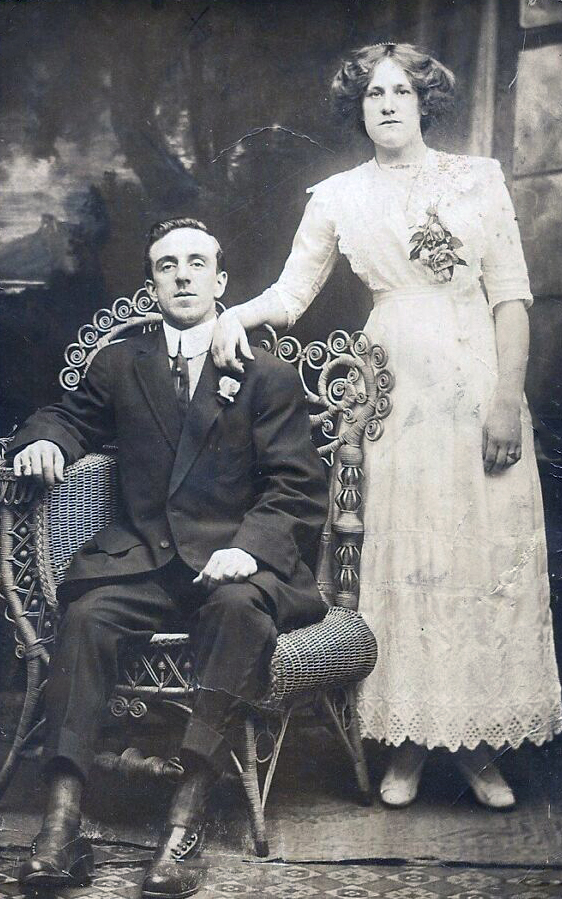 About a week later, when paging through the album again, I noticed that the face of the sailor seemed to match with the groom in a photo my mother showed me some years before of her grandmother Amelia's wedding day. My mother never knew her grandfather since he had passed away nearly two decades before she was born. However, she was very close with Amelia and was surprised by this photo of John in uniform since Amelia never spoke of her late husband's Naval service.
About a week later, when paging through the album again, I noticed that the face of the sailor seemed to match with the groom in a photo my mother showed me some years before of her grandmother Amelia's wedding day. My mother never knew her grandfather since he had passed away nearly two decades before she was born. However, she was very close with Amelia and was surprised by this photo of John in uniform since Amelia never spoke of her late husband's Naval service.
My research into the life of Cpl. Wellington Sahler, the namesake of the aforementioned VFW Post who was killed in action at the Meuse, bolstered my interest in the history of World War I. Thus, I knew I had to learn whether or not John Faulkner was a veteran of the Great War.
Since, at that time, the primary basis of my research was founded on two photographs, I did not have any specific details about John's service. From the 1920 census, I knew John had worked at the Philadelphia Navy Yard as a carpenter. Also, in contradiction to the photo showing him in uniform, a decade later, in the 1930 census, John had stated "no" under veteran status. Therefore, I contacted Jim Dunigan, a historian with the Ships of the Sea Maritime Museum in Savannah, GA, and asked for his help. Jim pointed out that the white braid wrapped around the right arm of John's jumper indicated that he was between the ranks of Apprentice Seaman and Seaman First Class at the time of the photo; aside from the census records and this new insight from Jim, the rest of the details known regarding John's background related to his personal life from stories Amelia frequently shared with my mother.
John was born in England on May 1, 1889. He arrived in Philadelphia in 1911 and two years later married Amelia Ransley. Sadly, John passed away from cancer in January 1933. During this time, they had two daughters, Leena, born in 1914, and my grandmother Hilda, born in 1918. Although Amelia had mentioned many times to my mother that John was a carpenter, she never mentioned his work at the Navy Yard. Later, we learned that Amelia's sewing box, which she had always shared that John had made for her, was, in fact, John's Ditty Box from his time at the Navy Yard.
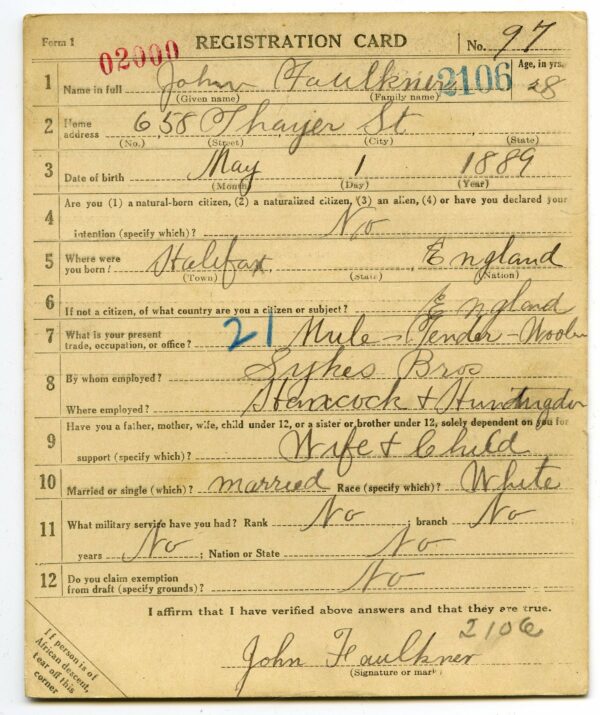 In September 2020, I decided to take a chance and submit an SF-180 form to the National Archives in St. Louis, MO, requesting John Faulkner's Naval records in hopes that some further information regarding his service would come to light. Based on the information Jim and my mother shared, I could provide my submission with details such as John's rank and the dates of his birth and death. Due to the pandemic, I learned that there would be a lengthier turnaround time for my request to be fulfilled. While I waited, I pursued other avenues of research.
In September 2020, I decided to take a chance and submit an SF-180 form to the National Archives in St. Louis, MO, requesting John Faulkner's Naval records in hopes that some further information regarding his service would come to light. Based on the information Jim and my mother shared, I could provide my submission with details such as John's rank and the dates of his birth and death. Due to the pandemic, I learned that there would be a lengthier turnaround time for my request to be fulfilled. While I waited, I pursued other avenues of research.
Despite pursuing several other avenues of research, I was still unable to confirm John's service. The waiting period for my SF-180 submission was nearing an end. On March 11, 2022, Amy Forsch, an archivist technician with the National Personnel Records Center (NPRC) in St. Louis, MO, searched extensively for John Faulkner's Naval record. She was also unable to find any mention of him in their records.
In May 2022, after a couple of years of researching John's life to confirm his service, the next big breakthrough surfaced. References included in the book, "The Philadelphia Navy Yard: From Birth of the US Navy to the Nuclear Age," confirmed that there was a J. Faulkner who served aboard the tugboat USS Samoset. This matches with John's employment as a carpenter at the Navy Yard.
Then, another archivist, Corey Stewart, at the National Archives, searched for John's record. She checked for any record of my great-grandfather in the Coast Guard, Navy Military files, Navy Civilian Personnel Folders, Navy Civilian Service Record Cards, Civil Service Cards, Civilian War Department Folders, Merchant Marine Licensing Files, and Merchant Marine Enrollee Files. Unfortunately, she could not find any record that he had served.
Bryan K. McGraw, Director of the Personnel Records Division at the National Archives, informed me that each sailor who served between the late 1800s and 1947 has a record in the form of a USN "brick," referring to the style of military personnel jacket. He had hoped that one was on file for John Faulkner. Theresa Fitzgerald, Director at the National Archives, noted that if John worked at the Navy Yard as a contractor, he would not have a Civilian Official Personnel File on record.
On August 19, Nathan Jordan, an archivist with the National Archives in Atlanta, GA, provided documentation that John worked for the Emergency Fleet of the US Shipping Board (USSB). Nathan sent John's WWI Classification list (below), which stated that he worked for the Emergency Fleet in 1918.
Although this new information brings my search, which has lasted for around three years, to a conclusion for now, it does leave one remaining question. USSB uniforms had two white piping stripes around the collar. The photo of John in uniform shows him with three white piping stripes around his collar, meaning he was wearing an official Navy uniform. Therefore, the photograph does suggest that, at one point, my great-grandfather did serve in the Navy.
Grace Schultz, an archivist with the National Archives in Philadelphia, followed up with her own search. She checked two series of records related to the USSB. However, she found no additional mention of John's name in these records.
A few noteworthy introductions to others who provided fruitful insights into my investigation: Christopher Eck, Executive Director, National Historical Publications and Records Commission at the National Archives in Washington, DC, is a descendant of the late Pvt. Lance Eck. Pvt. Eck, his distant cousin, chartered the Sahler-Sedan VFW Post—also, Dr. Jonathan Friedman, my former history professor from West Chester University of Pennsylvania. On several occasions, they were kind enough to share points of contact in their professional networks to advise me in my research.
Over the past few years, many veterans have supported my investigation into proving that my great-grandfather was the sailor in the photograph. An example of this support comes from Tom Totoris. Tom, retired Navy, served from 1971-1997. He is a member of VFW Post 5432. Recently, he mailed me historical items from the Great War era. Thank you to all the countless veterans, historians, archivists, librarians, and genealogists who offered their time and support in helping me learn more about my great-grandfather, John Faulkner.

TWS has allowed me to document my military accomplishments and enhance my recall of small items that were once forgotten. The recall allows individuals to share their military experiences and connect the dots with others who share the same. I enjoyed my military career and will always be proud of my country for allowing me to serve. The TWS database's documentation is an excellent tool for members to visit and assist with the recall of others who also served. The enjoyment of locating those lost Airmen that you once served with is always exciting.
Sgt Thomas Lumpkin, US Air Force Veteran
Served 1971-1975
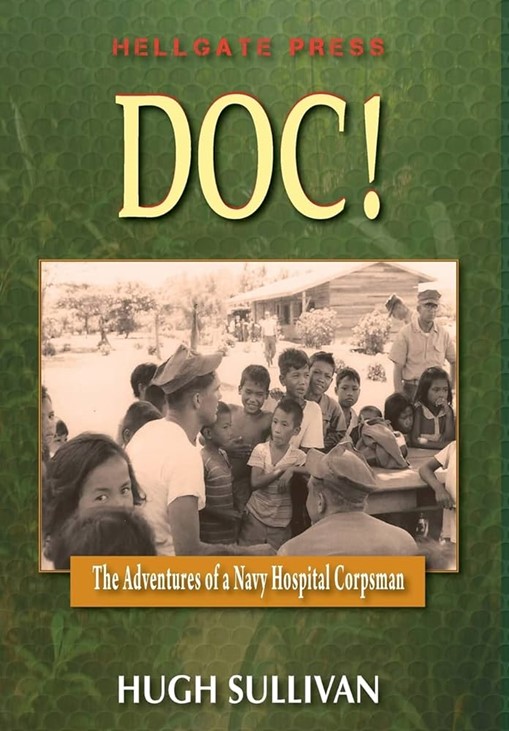 Hugh Sullivan served in the Navy for 39 years. Enlisting in 1961, he spent the first 16 of those years as a hospital corpsman. He would serve two tours in Vietnam, deploy to Operation Desert Storm, and rack up an impressive number of campaign and service ribbons and medals before retiring in 2000 as a Captain.
Hugh Sullivan served in the Navy for 39 years. Enlisting in 1961, he spent the first 16 of those years as a hospital corpsman. He would serve two tours in Vietnam, deploy to Operation Desert Storm, and rack up an impressive number of campaign and service ribbons and medals before retiring in 2000 as a Captain.
It's safe to say he probably has some really good stories to tell. It's fortunate for the rest of us that he's written a memoir about the lifetime of service he gave his country. "Doc! The Adventures of a Navy Hospital Corpsman" is that memoir.
"Doc," as many Marines and Corpsmen know, is a term of affection the Marines have for some of their battlefield medics. Grunts and Corpsmen alike will really enjoy Capt. Sullivan's reflections on his tours in Vietnam and his early deployments in Asia. But the book isn't just a memoir; there's something for military personnel and military medical troops in the book.
As the story continues into the later years of Sullivan's career, he begins to find frustrations with the egoism and political machinations that dominate the higher brass of the U.S. Navy. Along the journey, the author offers ways personnel of any rank can still be successful amid similar political infighting and other career difficulties.
Sullivan's book is a very readable, first-person account of what it was like to serve in the U.S. Navy during the latter half of the 20th century. He doesn't pull punches when describing himself or his experiences, so it makes this book a valuable read for anyone interested in the Vietnam or Desert Storm eras. Anyone who served as a corpsman will definitely love "Doc."
"Doc! The Adventures of a Navy Hospital Corpsman" is available on Amazon Kindle for $4.99 and paperback for $18.95.
 Cashe was born into a poor family in Oviedo, Florida, in 1970. He joined the U.S. Army 1989 as a Supply Specialist, but by 1993, he was retrained as an infantryman. He served in the Army as a squad leader, a Drill Sergeant, and, ultimately, a Platoon Sergeant. His career included deployments in the 1991 Gulf War, the former Yugoslavia, and the 2003 U.S.-led invasion of Iraq. But his second deployment to Iraq in 2005 would forever cement his legacy.
Cashe was born into a poor family in Oviedo, Florida, in 1970. He joined the U.S. Army 1989 as a Supply Specialist, but by 1993, he was retrained as an infantryman. He served in the Army as a squad leader, a Drill Sergeant, and, ultimately, a Platoon Sergeant. His career included deployments in the 1991 Gulf War, the former Yugoslavia, and the 2003 U.S.-led invasion of Iraq. But his second deployment to Iraq in 2005 would forever cement his legacy. s own uniform caught fire.
s own uniform caught fire.  Cashe died weeks later, on November 8, 2005, at 35 years old. He was initially awarded the Silver Star for his heroism and dedication to his troops that night, but only because his battalion commander didn't realize the extent of Cashe's injuries that night and the excessive pain he must have experienced as he rescued his men.
Cashe died weeks later, on November 8, 2005, at 35 years old. He was initially awarded the Silver Star for his heroism and dedication to his troops that night, but only because his battalion commander didn't realize the extent of Cashe's injuries that night and the excessive pain he must have experienced as he rescued his men. 

 By the fall of 1944, Japan's imperial ambitions faltered, and the Allies were steadily advancing towards the Japanese home islands. The strategically important Philippines was a primary target for the Allies, as its capture would facilitate the liberation of other Southeast Asian nations and disrupt Japan's supply lines.
By the fall of 1944, Japan's imperial ambitions faltered, and the Allies were steadily advancing towards the Japanese home islands. The strategically important Philippines was a primary target for the Allies, as its capture would facilitate the liberation of other Southeast Asian nations and disrupt Japan's supply lines. Meanwhile, the Japanese Center Force, commanded by Vice Adm. Takeo Kurita, pressed on toward Leyte Gulf. On October 25, 1944, this force encountered the American escort carriers and their supporting ships in the Battle of Samar. Outnumbered and outgunned, the American vessels displayed remarkable courage and resourcefulness. They launched a desperate counterattack, deploying aircraft and employing evasive maneuvers to fend off Kurita's superior Fleet. While the Battle of Samar was a tactical victory for the Japanese, the heroic efforts of the U.S. escort carriers and their crews disrupted Kurita's advance. They forced him to withdraw, saving the invasion force at Leyte.
Meanwhile, the Japanese Center Force, commanded by Vice Adm. Takeo Kurita, pressed on toward Leyte Gulf. On October 25, 1944, this force encountered the American escort carriers and their supporting ships in the Battle of Samar. Outnumbered and outgunned, the American vessels displayed remarkable courage and resourcefulness. They launched a desperate counterattack, deploying aircraft and employing evasive maneuvers to fend off Kurita's superior Fleet. While the Battle of Samar was a tactical victory for the Japanese, the heroic efforts of the U.S. escort carriers and their crews disrupted Kurita's advance. They forced him to withdraw, saving the invasion force at Leyte.


 After 186 years of accidents, death, and destruction, you're bound to have a couple of ghosts hanging around, even in Wyoming – and F.E. Warren has all the ghosts you might expect.
After 186 years of accidents, death, and destruction, you're bound to have a couple of ghosts hanging around, even in Wyoming – and F.E. Warren has all the ghosts you might expect.  Scouts and cavalry from Fort Russell struck out from Cheyenne to hunt down marauding tribesmen who were using southern Montana as a base to conduct raids, steal livestock, and kill settlers. The American cavalry's chief tactic was to fight the Natives wherever they met them, turning the area into a 90,000–square–mile battlefield.
Scouts and cavalry from Fort Russell struck out from Cheyenne to hunt down marauding tribesmen who were using southern Montana as a base to conduct raids, steal livestock, and kill settlers. The American cavalry's chief tactic was to fight the Natives wherever they met them, turning the area into a 90,000–square–mile battlefield.  For the last 100-plus years, even after Fort Russell became F.E Warren Air Force Base, military personnel and civilians alike have reported seeing uniformed cavalry troops patrolling areas in and around the base. Warren is known as one of the most haunted places in Wyoming and the United States in general, and it's not only because of the spectral troopers.
For the last 100-plus years, even after Fort Russell became F.E Warren Air Force Base, military personnel and civilians alike have reported seeing uniformed cavalry troops patrolling areas in and around the base. Warren is known as one of the most haunted places in Wyoming and the United States in general, and it's not only because of the spectral troopers. 

 Kareem Abdul-Jabbar, who authored the book "Brothers in Arms: The Epic Story of the 761st Tank Battalion, WWII's Forgotten Heroes," wrote of them: "Certainly, they were General Patton's most effective unit… Because they were a replacement unit, they often shifted around to different areas. In every instance, their presence meant that competent tank support had arrived. The commander of the 17th Airborne, Gen. John Miley, felt that he could send many more of his Soldiers home alive as a direct result of the effective support of the 761st."
Kareem Abdul-Jabbar, who authored the book "Brothers in Arms: The Epic Story of the 761st Tank Battalion, WWII's Forgotten Heroes," wrote of them: "Certainly, they were General Patton's most effective unit… Because they were a replacement unit, they often shifted around to different areas. In every instance, their presence meant that competent tank support had arrived. The commander of the 17th Airborne, Gen. John Miley, felt that he could send many more of his Soldiers home alive as a direct result of the effective support of the 761st." Sgt. Ruben Rivers of the 761st was posthumously awarded the Medal of Honor on January 13, 1997, by President Bill Clinton. The award was presented to Rivers' sister, Grace Wood, ford in attendance that day at the White House. His citation reads:
Sgt. Ruben Rivers of the 761st was posthumously awarded the Medal of Honor on January 13, 1997, by President Bill Clinton. The award was presented to Rivers' sister, Grace Wood, ford in attendance that day at the White House. His citation reads: Jackie, Fort Riley 1942
Jackie, Fort Riley 1942 A monument featuring the kneeling Sgt. Ruben Rivers and, dedicated to the 761st, was unveiled at Fort Cavazos, Texas, during a ceremony attended by surviving veterans on November 10, 2005, as a "… permanent tribute to soldiers who had served and continued to serve throughout the world for liberty, honor, and democracy." Another marble panel with French text inscription was placed in the town of Morville-les-Vic dedicated to twelve soldiers of the 761st Tank Battalion who lost their lives in the town's liberation and are named on it. A third memorial for the Black Panthers, who were attached to the 87th Infantry Division while fighting during the Battle of the Bulge in 1944/45, was dedicated in the Belgian town of Tillet in 2021. And today, there's a bronze one at Camp Claiborne, too.
A monument featuring the kneeling Sgt. Ruben Rivers and, dedicated to the 761st, was unveiled at Fort Cavazos, Texas, during a ceremony attended by surviving veterans on November 10, 2005, as a "… permanent tribute to soldiers who had served and continued to serve throughout the world for liberty, honor, and democracy." Another marble panel with French text inscription was placed in the town of Morville-les-Vic dedicated to twelve soldiers of the 761st Tank Battalion who lost their lives in the town's liberation and are named on it. A third memorial for the Black Panthers, who were attached to the 87th Infantry Division while fighting during the Battle of the Bulge in 1944/45, was dedicated in the Belgian town of Tillet in 2021. And today, there's a bronze one at Camp Claiborne, too. 

 That included a secretive group of witches and occultists in Highcliffe-on-Sea, who decided to come together and do their part to defend England the best way they knew how. Meeting in a forest in August 1940, the witches launched what they called Operation Cone of Power, a magical attack on Adolf Hitler himself – even though he was thousands of miles away in Berlin.
That included a secretive group of witches and occultists in Highcliffe-on-Sea, who decided to come together and do their part to defend England the best way they knew how. Meeting in a forest in August 1940, the witches launched what they called Operation Cone of Power, a magical attack on Adolf Hitler himself – even though he was thousands of miles away in Berlin.  On Lammas Eve, shortly before midnight on August 1, 1940, a coven of 17 witches and people descended from witches gathered in the New Forest, a mystical and ancient woodland in southern England. They chose this location for its spiritual significance and the natural energy they believed it contained. In the heart of the forest, the witches formed a circle near an ancient gallows tree called the "Naked Man" with Gardner at the center and conducted their ritual.
On Lammas Eve, shortly before midnight on August 1, 1940, a coven of 17 witches and people descended from witches gathered in the New Forest, a mystical and ancient woodland in southern England. They chose this location for its spiritual significance and the natural energy they believed it contained. In the heart of the forest, the witches formed a circle near an ancient gallows tree called the "Naked Man" with Gardner at the center and conducted their ritual. Those involved in the ritual claimed that they did perceive a change in Hitler's demeanor shortly after their operation. Hitler did indefinitely postpone Operation Sea Lion, the planned invasion of Britain, just a month and a half after the Cone of Power was cast. He then declared war on the United States after the Japanese attack on Pearl Harbor. He attacked the Soviets less than a year later.
Those involved in the ritual claimed that they did perceive a change in Hitler's demeanor shortly after their operation. Hitler did indefinitely postpone Operation Sea Lion, the planned invasion of Britain, just a month and a half after the Cone of Power was cast. He then declared war on the United States after the Japanese attack on Pearl Harbor. He attacked the Soviets less than a year later. 
 In these more than two dozen sessions, one common theme has emerged. Veterans are asking how they can help other Veterans. That is, what benefits or programs are there for a buddy facing difficulties that can help him/her change directions? Two benefits that I point out address are Financial Wellness and Veteran Homeless. Let me explain.
In these more than two dozen sessions, one common theme has emerged. Veterans are asking how they can help other Veterans. That is, what benefits or programs are there for a buddy facing difficulties that can help him/her change directions? Two benefits that I point out address are Financial Wellness and Veteran Homeless. Let me explain. Veteran Homelessness
Veteran Homelessness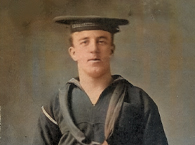
 About a week later, when paging through the album again, I noticed that the face of the sailor seemed to match with the groom in a photo my mother showed me some years before of her grandmother Amelia's wedding day. My mother never knew her grandfather since he had passed away nearly two decades before she was born. However, she was very close with Amelia and was surprised by this photo of John in uniform since Amelia never spoke of her late husband's Naval service.
About a week later, when paging through the album again, I noticed that the face of the sailor seemed to match with the groom in a photo my mother showed me some years before of her grandmother Amelia's wedding day. My mother never knew her grandfather since he had passed away nearly two decades before she was born. However, she was very close with Amelia and was surprised by this photo of John in uniform since Amelia never spoke of her late husband's Naval service.


 Hugh Sullivan served in the Navy for 39 years. Enlisting in 1961, he spent the first 16 of those years as a hospital corpsman. He would serve two tours in Vietnam, deploy to Operation Desert Storm, and rack up an impressive number of campaign and service ribbons and medals before retiring in 2000 as a Captain.
Hugh Sullivan served in the Navy for 39 years. Enlisting in 1961, he spent the first 16 of those years as a hospital corpsman. He would serve two tours in Vietnam, deploy to Operation Desert Storm, and rack up an impressive number of campaign and service ribbons and medals before retiring in 2000 as a Captain.